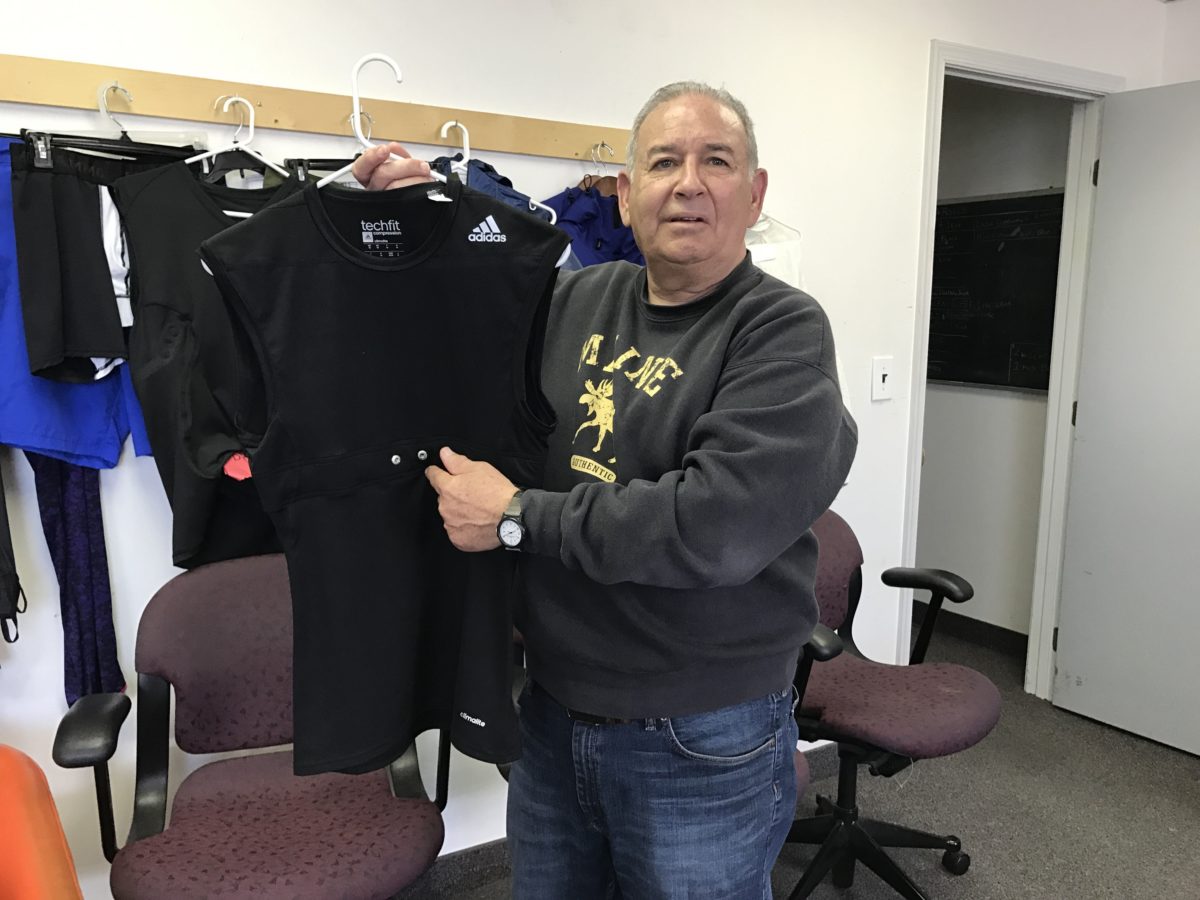When Philip Spector arrived in Baltimore in the 1960s, the city’s textile industry was booming. Brands like London Fog, Joseph A. Bank and Haas Tailoring all had sizable operations in the downtown area between Baltimore, Lombard, Howard and Paca Streets.
He recalls a veritable army of seamstresses and tailors: thousands in that area alone.
Since 1994, the fifth-floor of the Wicomico Building in Pigtown has been home to Spector’s company, Fashions Unlimited. The workspace has machines, cutting tables and other sewing tools. It was humming on our early morning visit. Spector started the company in 1976, and specialized in working with companies to develop prototypes of new kinds of apparel. It’s led to a number of innovative projects, like a sports bra with a heart monitor and a jacket with enough insulation to ascend Mt. Everest.
Throughout its existence, Fashions Unlimited specialized in stretch fabric. That’s grown into work developing garments that weave technology directly into clothing. Talk about smart garments often includes visions of sensors and other devices embedded directly into the fabric of clothing. Spector has a unique role in figuring out how that will play out, and he’s working with big brands.
For one such project, he worked with Adidas to develop apparel that has sensors built-in. It’s called the miCoach techfit line. Users snap a device in, and it can track data on heart rate, as well as motion.
“It monitors the whole team on one computer on the sideline,” he said of one use with a European soccer team.
Along with helping to find a way to fit technology into clothing, Spector helps clients figure out how to make the products commercially viable, including not just a use but also sourcing of materials for production. He’s seen the technology develop rapidly, and knows that it will continue as people will continue to want new products.
“When I started with heart monitors, it was, ‘How do you get from that pod to your wrist?’” he said. “Now they’re making it where it’s on the field, and it shows every player on the field.”
The devices involved are also getting less bulky. Looking toward the future, he sees devices being integrated directly into the fabric.
While Baltimore may no longer be a center for production, the city’s innovation community can play a role in continuing to keep the industry moving forward.
Recently, Spector worked with a Baltimore-based company that is developing a way to weave the technology into the fiber of a garment itself.
DiPole Materials is developing yarns that can conduct electricity through body movement.
“We manufacture a piezoelectric yarn, meaning that when the yarn stretches or bends it generates electricity,” said Ken Malone, CEO of the company. “When we weave the piezo yarn into a textile with some conductive fibers, the resulting textile emits a signal when it is moved. Thus, we can detect motion without batteries and we can generate small amounts of electricity for powering other types of sensors.”

The technology for the yarn was developed by James West, who became a professor at Johns Hopkins following a long career at Bell Labs. He co-invented the foil-electret microphone, which is used in telephones and audio recording devices, and holds a total of 250 patents. DiPole is licensing the technology from JHU for commercialization.
Malone, who is joined by CFO Kelli Booth and Chief Science Officer Scott Gaboury, sees applications in health as well as athlete tracking.
The yarn would be woven into a piece of clothing, so it would maintain the look and feel the same as a typical garment. The built-in power source and motion tracking means wearable technology doesn’t necessarily have to involve a device.
“We get rid of the bulk, and we don’t have a battery,” Malone said.
The first step was figuring out how to weave the fabric itself. When creating initial prototypes, DiPole got connected with Annet Couwenberg, a professor in fiber arts at Maryland Institute College of Art. That helped the company get access to weaving expertise.
For her part, Couwenberg helped start a class on smart textiles after seeing how digital and fiber were integrating.
“The design world and the art world are moving so much into tech. They need to know what the language is and understand the basics, otherwise you can’t collaborate with people who are making new innovations,” she said.
Couwenberg wants to create more connections between MICA students and innovators who want to tap people with knowledge of how to translate more traditional forms into new technologies.
“Our students really understand making, but they can put it in context, too,” she said.
With the textile industry already woven into the fabric of the city and a company in Under Armour that has shown interest in pursuing smart garments as well, there are signs that the community could grow.







